Introduction The veterinary activities in the Central Rift region and Masai Mara went on successfully during the month of June, 2008
Introduction
The veterinary activities in the Central Rift region and Masai Mara went on successfully during the month of June, 2008. Some of the cases attended to include a White rhino in Lake Nakuru National Park, elephants in Masai Mara and rescue of animals entangled with snares in Naivasha area. Monitoring of cases of mange infestation in cheetahs and Thompson gazelles is still a continuous exercise and more data is being collected concerning the disease. The David Sheldrick Wildlife Trust (DSWT) have pledged to buy basic laboratory equipment required in the lab to facilitate biological samples collection and processing in Mara ecosystem.
Treatment of a wounded elephant in Masai Mara National Reserve
The sub-adult male elephant had a deep penetrating wound on the left shoulder that extended to the scapular bone. The wound was already infected and discharging a lot of pus. It was so painful such that the animal could not move much and preferred staying alone in a swampy area where it could readily get water and feeds. It was found near Main Governors lodge in a swampy area in Masai Mara.
Chemical immobilization and capture
The elephant was captured by darting using 10mgs of etorphine hydrochloride combined with 1000 i.u hyaluronidase. It was darted using Dan-inject dart-gun propelled from about 20 meters. It took about 6 minutes to become recumbent.
Physical examination and treatment
The wound was examined and probed by gauze swabs attached to a long forceps. Most of the soft tissues were affected and the wound pierced through to the scapular bone. It was full of tissue debris and pus accumulation. A lot of pus was expressed out and the wound cleaned with water then debrided with 10% hydrogen peroxide and later treated with a tincture of iodine solution.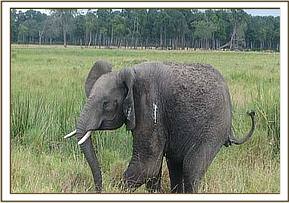
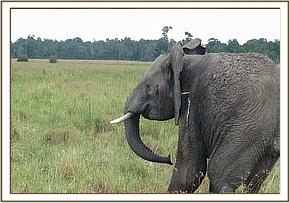

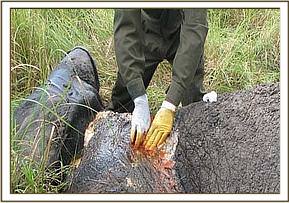


Other treatments included administration of long-acting (20%) oxytetracycline intramuscularly and multivitamins. The wound was also sprayed with oxytetracycline spray to keep off flies and enhance healing.
It was then revived from anaesthesia using 24mgs of Diprenorphine hydrochloride administered through the ear-vein.
Prognosis
It had good chances of healing after the treatment because it was still in good body condition and only soft tissues were affected.
Postmortem examination of an elephant that died in Aitong area:
This was an adult male elephant that was found dead near Aitong market center, it was reported to KWS warden by the area residents who said it had injuries on the trunk and back. It was a tuskless elephant of about 40 years old. 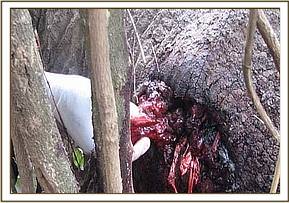


The postmortem examination revealed that it died of internal haemorrhage; the wound at the back must have pierced through internal organs especially the lungs leading to profuse hemorrhage and death just after a few days. Another injury was on the trunk causing inflammation of the mucosa and blockage of the airway. They were suspected to be spear wounds inflicted by villagers trying to scare the animal away from the village.
Cases of human-wildlife conflict involving elephants and humans are on the rise in the area due to water and feed scarcity for elephants and human population increase.
Preview
The rhino monitoring team and the management of Lake Nakuru National Park reported a case of a white rhino which had difficulties in walking and was found lying down most of the time; it had also started loosing its body condition. It was suspected that the three year old male rhino must was injured in a fight between him and one of the adult males during breeding season. The area veterinarian was then informed to take an immediate action to rescue the animal. . It was found to have a dislocation of the tarsal joint of the right hind limb. The rhino has since been treated twice and moved to a boma for restriction of movement, closer attention and further treatment. Feeds, water and mineral supplements are being provided to it in the boma. Chances of recovery will depend on its ability to stand and move around and its appetite. It is still being monitored and treated by the veterinarian on a daily basis until its recovery.
Identification
Name: Yannik
Age: 3 years
Sex: Male
Ear-Notch No. 50W60
Location: Lake-Shore near mouth of Makalia River.
Clinical signs
The animal preferred being recumbent most of the time and could only be seen walking for very short distance in the evening in search of water and feeds. It was unable to bear weight on the right hind leg and was exhibiting carrying lameness. The tarsal joint of the right hind leg was weak and completely flexed; the whole limb was slightly swollen as compared to the normal left leg. The affected limb was already undergoing muscle atrophy and becoming shorter compared to left leg. The rhino could be seen walking while dragging the affected limb and with very little support from the limb.
There were superficial lacerative wounds on the inguinal region with minimal haemorrhage and pus exudation in some parts. It still had good appetite and a fair body condition.
Chemical restrain
Decision was made by the veterinarian to restrain the animal then examine the limb properly to determine whether it was a dislocation of the joint or a fracture of the metatarsal bones. It was also to be treated for wounds and bacterial infections in the joint and from the wounds. The animal was then restrained by chemical immobilization. It was darted on the left thigh using 3.5mgs of etorphine hydrochloride combined with 60mgs of Xylazine hydrochloride. The drugs took effect after 6 minutes and good anaesthesia was achieved as required for treatment of the rhino. Nalorphine hydrobromide (5mgs) was administered through the superficial ear-veins to help improve the respiration rate. 
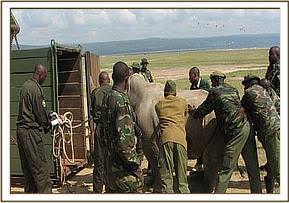
Physical examination
After capturing the animal, it was blindfolded, eyes treated with Opticlox ointment to prevent infection and dessication, it was also dowsed with water to enhance thermoregulation.
The vital physiological parameters were taken and recorded to ensure that the rhino was in stable anaesthesia throughout treatment time; these are shown in the table below.
Vital physiological parameters of the white rhino
Parameter
Findings
Respiratory rate
8 cycles/ minute, deep and regular
Body temperature
38.0 degrees Celsius
Pulse rate
72 cycles/ minute, strong and regular
Capillary refill time (CRT)
2 seconds
Colour of oral and conjuctival membranes
Pink and moist
The affected limb was palpated and flexed several times but there was no crepitation of bones at the joint, which means there could be no fracture of any bone at the joint. There was hyper-flexion of the joint to the cranial and caudal directions freely without much resistance and this showed that the tibial and metatarsal bones were not properly attached to the joint. The joint ligaments seem to be torn and weak and not re-enforcing the joint as required. It was then revealed that the animal was suffering from a dislocation of the carpal joint. There was no injury or open wounds on the joint hence reduced chances of developing arthritis.
Treatment
The wounds at the inguinal region were cleaned using water then debrided using 10% hydrogen peroxide and irrigated with tincture of iodine and oxytetracycline spray applied. Other drugs administered included 100mls of Betamox antibiotic intramuscularly, 40mgs of dexamethasone intramuscularly, 50mls of multivitamin intramuscularly and ivermectin subcutaneously. It was also marked with an ear-notch for identification. Bales of hay and clean drinking water were provided to the animal after the treatment.
Due to massive weight of the rhino and the location of the joint it is not practical to attempt fixing the joint by the available means. The most important thing is to move the animal to a small enclosure, supplement with feeds and water; this also restricts its movement and enhances healing.
Anaesthesia Reversal
After treatment, the rhino was revived from anaesthesia using 24mgs of Diprenorphine hydrochloride combined with 10 mgs of Atipamezole hydrochloride administered through the superficial ear vein. Another 12mgs of Diprenorphine was administered intramuscularly to enhance a quick recovery from anaesthesia. Naltrexone (50mgs) administered intramuscularly for complete reversal of narcosis. It took about 2 minutes to recover from anaesthesia.
The animal was later monitored by the rhino patrol team daily and was found to be making good progress.
Second treatment and relocation to a boma
Three days after the first treatment it was reported to be greatly deteriorating probably due to intensive pain and inability to move and feed freely. The decision was then made to repeat the treatment and move the animal to a boma for feeds and water supplementation restrict movement and further treatment. The KWS capture team from Nairobi together with the Central Rift veterinary team organized and moved the rhino to a boma on 8th June, 2008.
Chemical restrain and loading
The animal was restrained by tranquilization. It was darted on the neck muscles using 1mg of etorphine hydrochloride combined with 40mgs of azaperone. The drugs took effect after about 5 minutes, the animal got tranquilized but remained standing and it was later walked into the crate. Anaesthesia was then revived partially using 100mgs of Naltrexone administered through the superficial ear-veins.
The crate was then lifted onto a Volvo truck and driven to the rhino boma in Lake Nakuru Park approximately 8 Kms from where the rhino was captured. The rhino was then released into the boma.
Second treatment
It was also treated for the second time for bacterial infection, inflammation and pain, this included 100mls of Betamox antibiotic intramuscularly, 40mgs of dexamethasone intramuscularly, 50mls of multivitamin intramuscularly. All the visible wounds on the body were treated using oxytetracycline spray.
Boma care and management
Feeds provided in the boma included freshly cut grass, hay, dried Lucerne, molasses, horse cubes, salt/mineral licks, sugarcane and water. Molasses and mineral salt licks are in powder form and are supposed to be mixed with feeds everyday as per the demand of the rhino. Freshly cut grass, hay and water will be provided ad-libitum. The boma has to be kept dry and cool, water trough to be cleaned and refilled regularly to avoid contamination. The boma has to be swept clean regularly to avoid feeds mixing with dung.
Prognosis
The animal has good chances of recovery only if it is able to stand and move around in the boma and also able to feed and drink water normally. It is still a young rhino and much of its bones have not calcified hence better chances of recovery. There is still substantial amount of risk of the animal developing septicemia due to formation of the decubital wounds on the affected joint. The rhino is already adapting to walking on the metatarsals on both legs, this has been caused by atrophy and imbalance of the hind limbs. It is likely to recover but both hind legs will remain deformed. 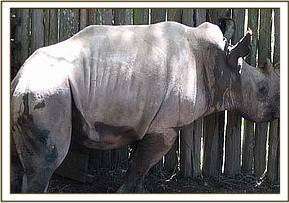

Removal of a snare from a giraffe in Marula Estates in Naivasha
One of the recently introduced giraffes in Marula got entangled on the left hind leg by a snare and the management of the ranch reported this case to the veterinarian for attention. The wire was loosely attached and had not inflicted any injury to the animal. The giraffe was then captured by darting and the snare removed before being released to the wild. It was a male adult giraffe in a very good body condition.

Removal of snares from common zebras in Naivasha area
There are several cases of zebras being entangled with snares in most ranches around lake Naivasha, during the month of June the veterinary team managed to remove snares from 4 zebras in different locations. One zebra was captured and desnared in Aquilla farm,

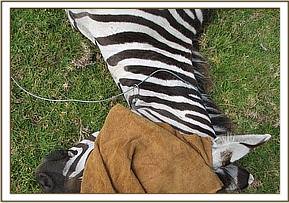

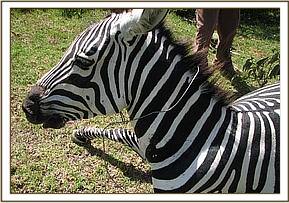

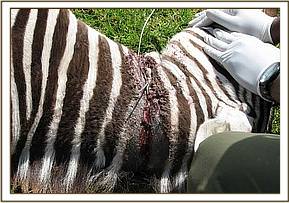
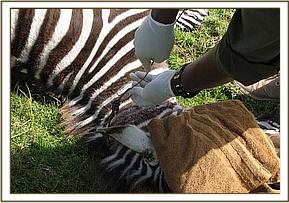

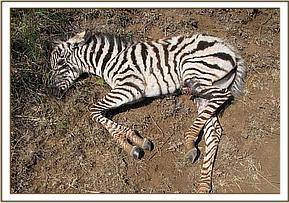
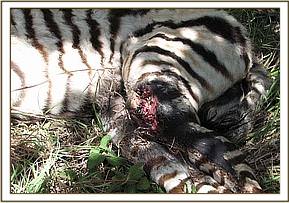
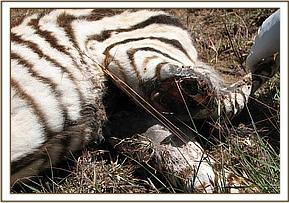

Postmortem examination of a White rhino (Ceratotherium simum) in Lake Nakuru National Park
History
The sub-adult male white rhino sustained injuries after a fight with another adult male probably during mating time. The tarsal (ankle) joint of the right hind leg was dislocated and the animal was not able to walk properly and preferred lying down most of the time due to pain from the joint. It also sustained lacerative wounds on the perineum, prepuce and abdomen; these could have been inflicted by the horns of the aggressive male.
It was reported for veterinary attention and from then it has been under supportive therapy for one month and has been in a boma in Naishi for two weeks under intensive care.
While in the boma, it developed several bruises and decubital wounds due to long hours of being recumbent. Both the hind legs got bruised and pus oozing from the wounds, later septicemia set in and loss of appetite. The animal was in pain and had lost much of its body condition. It was then decided that the animal be euthanized (humane killing) because there were no signs of recovery and also to alleviate pain and suffering of the animal but then it died shortly before it was euthanized on 25/06/2008 at dawn.
Postmortem examination was conducted by the veterinarian on the ground and the report is as follows.
Animal identification
Name: Yannik
Age: 3 years
Sex: Male
Ear-Notch No. 50W60
Location: Rhino boma in Naishi
Postmortem findings
The animal was severely emaciated, with superficial bruise wounds on the abdominal region, thighs, inguinal region and shoulder. These wounds were already infected and pus discharges seen. Affected limb was atrophied (shorter compared to left leg). The dislocated joint had developed severe open wounds and the distal part of tibia bone could be seen emerging through the wound. When the joint was flexed there was crepitation of the tarsal bones.
The joint was then opened for a thorough postmortem examination and revealed a complete separation of all the tarsal bones (proximal, middle and distal tarsal bones). Due to looseness of the joint and the massive weight of the rhino all the joint cartilages got ruptured and later arthritis (joint inflammation) set in causing more pain and septicemia to the animal. Even the ankle joint of the normal left leg also developed severe septic wounds because the animal had adapted to walking on the ankles, this also caused a lot of pain and the animal was unable to stand or walk during the last few days in the boma. 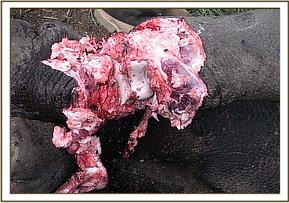
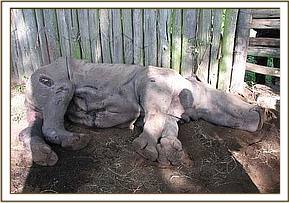

Cause of death
The animal had been under intense pain and poor appetite, it was therefore unable to feed or drink water adequately while in the boma, it then became emaciated and dehydrated, this together with septicemia due to several infected wounds on the body led to body condition deterioration and death.
Carcass disposal
After postmortem examination, both the horns were recovered from the animal and the carcass buried about 100 meters from the boma in a deep pit where no predator could extract it.
Conclusion
The veterinary activities are going on successfully in Masai Mara and other parts of Central Rift region. Basic laboratory equipment and laboratory technician are required to help improve the veterinary services and research activities in the region. Other constraints are lack of internet access and a refrigerator for storing biological samples for diseases diagnosis and research activities in Mara research station. There are plans to acquire some basic laboratory equipment in the near future through support from David Shedrick Wildlife Trust (DSWT); this will go along way in improving the quality of veterinary services in the Mara and Central Rift region.
Report by: Dr. Domnic Mijele